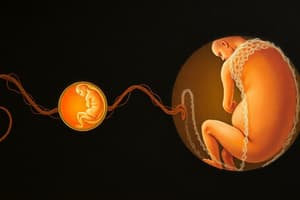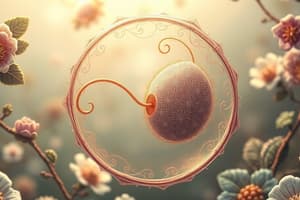Podcast
Questions and Answers
A researcher is studying the very early stages of pregnancy. At what point would they expect to observe a blastocyst forming?
A researcher is studying the very early stages of pregnancy. At what point would they expect to observe a blastocyst forming?
- Around the end of the embryonic stage, at 8 weeks.
- Approximately 5 to 6 days after fertilization. (correct)
- Immediately after fertilization, within the first 24 hours.
- During the fetal stage, around 9 weeks after fertilization.
Which of the following is the correct sequence of the stages of prenatal development?
Which of the following is the correct sequence of the stages of prenatal development?
- Germinal, Fetal, Embryonic
- Germinal, Embryonic, Fetal (correct)
- Embryonic, Germinal, Fetal
- Fetal, Germinal, Embryonic
During which stage of prenatal development do the major organs and body systems begin to form in the developing embryo?
During which stage of prenatal development do the major organs and body systems begin to form in the developing embryo?
- Blastocyst Stage
- Germinal Stage
- Fetal Stage
- Embryonic Stage (correct)
A woman is 7 weeks pregnant. According to the stages of prenatal development, in which stage is her baby?
A woman is 7 weeks pregnant. According to the stages of prenatal development, in which stage is her baby?
Which of the following processes occurs during the germinal stage of prenatal development?
Which of the following processes occurs during the germinal stage of prenatal development?
Flashcards
Blastocyst
Blastocyst
An early stage of development in a fertilized egg (zygote) that forms about 5 to 6 days after fertilization and is ready to implant into the uterine wall.
Embryonic Development
Embryonic Development
The process by which a fertilized egg (zygote) grows and develops into a fully formed baby inside the mother’s womb.
Germinal Stage
Germinal Stage
The first stage of embryonic development, lasting from 0-2 weeks after fertilization.
Embryonic Stage
Embryonic Stage
Signup and view all the flashcards
Fetal Stage
Fetal Stage
Signup and view all the flashcards
Study Notes
- Human development refers to the continuous body changes from fertilization to death.
- This development has two stages: prenatal (before birth) and postnatal (after birth).
- A single cell develops into an embryo, then a fetus, before birth.
Fertilization
- Fertilization involves the fusion of an egg and sperm cell.
- It begins with sperm entering the vagina post-ejaculation.
- Sperm cells move through the uterus into the uterine tube by flagellum.
- Enzymes released from the sperm head help with penetration.
- Once the zona pellucida is penetrated, changes occur to prevent more sperm from attaching.
- The united egg and sperm form a zygote.
- Within 36 hours, the zygote starts dividing while traveling through the fallopian tube.
- The original cell divides into two cells.
- From the two-cell stage to about nine weeks after fertilization, the growing structure is an embryo.
- A blastocyst is an early-stage in a fertilized egg forming approximately 5-6 days post-fertilization; ready to implant into the uterine wall.
Three functions of fertilization.
- Restoring the diploid number (2n) of chromosomes as sperm contributes its haploid (n) set to the haploid set in the ovum
- Determining the offspring's sex in mammals and many other animals.
- Stimulating reactions in the egg, allowing for development to occur.
Development Before Birth
- Prenatal or anternal development begins with fertilization and continues to fetal development until birth.
- The embryo is formed early in the development stage at week eight.
- Fetal development involves the process by which a fertilized egg (zygote) grows and develops into a fully formed baby inside the mother's womb and occurs in three main stages.
Germinal Stage (0–2 weeks)
Embryonic Stage (3–8 weeks)
Fetal Stage (9 weeks – birth)
- Amniotic sacs protect the developing baby inside the uterus.
- The placenta, formed from tissue, is a station between the mother and embryo.
- The embryo connects to the placenta via the umbilical cord.
- The umbilical cord's blood vessels transport food and oxygen, with waste moving between the embryo and placenta.
Stages of Fetal Development
- First Stage: From zygote formation to the end of the 6th week; the head starts to differentiate, eyes appear distinctly, and the heart develops.
- Second Stage: From the 7th to the 12th week; the developing embryo shows human features, organs develop completely, and the reproductive organs begin to develop.
- Third Stage: Begins at week 13 and goes to the end of the 22nd week.
- Fourth Stage: From beginning of the 23rd week up until delivery; all body systems complete development, leading to the ability to move hands and feet.
- The body inside the uterus develops and grows after 38 weeks.
- During labor, the baby is still connected to the placenta through the umbilical cord, clamped and then cut.
- Contractions happen in the uterus, and the mother experiences labor pains.
- A piece of the umbilical cord remains attached to the newborn, dries, and falls off, leaving the navel as a lifelong scar.
Development after Birth
- The postpartum or postnatal time frame starts right after childbirth and lasts about six weeks while a bodies hormones/ uterus goes back a non pregnant.
- Shortly after birth, the babys begins breathin.
- The mother and the baby are advised to stay at around three to four days in the hospital following a caesarean section delivery.
- Humans go through various stages of development
- Childhood begins around 18 months and continues until the age of 13.
- Adolescence begins after the thirteenth year and continues through the teenage years.
- Adulthood begins at about 20 years of age.
Studying That Suits You
Use AI to generate personalized quizzes and flashcards to suit your learning preferences.
Related Documents
Description
Human development involves prenatal and postnatal stages. Fertilization unites egg and sperm, forming a zygote. The zygote divides into two cells, eventually becoming an embryo around nine weeks after fertilization.





